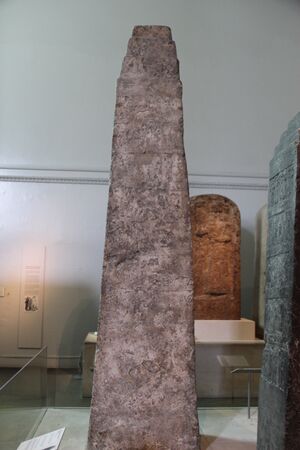آشور ناصر پال الأول
| آشور ناصر پال الأول Ashurnasirpal I | |
|---|---|
| ملك آشور | |
 The White Obelisk sometimes associated with Ashurnasirpal I (although it is usually dated to the reign of Ashurnasirpal II) | |
| King of the Middle Assyrian Empire | |
| العهد | 1050–1031 BC |
| سبقه | Shamshi-Adad IV |
| تبعه | Shalmaneser II |
| الأنجال | Shalmaneser II, Ashur-rabi II |
| الأب | Shamshi-Adad IV |
آشور ناصر أپلي الأول Aššur-nāṣir-apli I ، وتـُنقش maš-šur-PAB-A, “الإله أشور هو حامي الوريث”، كان ملك آشور، 1049–1031 ق.م.، and the 92nd to appear on the Assyrian Kinglist. He was the son and successor of Šamši-Adad IV, and he ruled for 19 years[i 1] during a troubled period of Assyrian history, marked by famine and war with nomads from the deserts to the west. He is best known for his penitential prayer to Ištar of Nineveh.
. . . . . . . . . . . . . . . . . . . . . . . . . . . . . . . . . . . . . . . . . . . . . . . . . . . . . . . . . . . . . . . . . . . . . . . . . . . . . . . . . . . . . . . . . . . . . . . . . . . . . . . . . . . . . . . . . . . . . . . . . . . . . . . . . . . . . . . . . . . . . . . . . . . . . . . . . . . . . . . . . . . . . . . .
السيرة
According to a royal hymn composed in his honor, he was born “in the mountains that nobody knows,” suggesting he may have been born in exile, or perhaps a literary device, as it continues: “I was without understanding and I prayed not of your majesty.” It relates that, when Ištar appointed him to the kingship, he had restored her overthrown cult. Known from a single copy from the library of Ashurbanipal, it includes a plea to the goddess to restore him to health from the sickness that afflicted him, citing his temple-restoration, and devotions, to persuade her. It addresses Ištar of Nineveh, and Ištar of Arbil, as though they were separate deities.[1] A second, fragmentary literary prayer thanks her for her favor.[2]
A single short brick-inscription comes from his palace in Assur,[i 2] which was located between the south-west front of the ziggurat and the Anu-Adad temple. The White Obelisk[i 3] is sometimes attributed to him by historians, but more usually to his later namesake, Aššur-nāṣir-apli II, because its internal content (hunting, military campaigns, etc.) better matches what is known about his reign.[3] The Synchronistic Kinglist[i 4] gives his Babylonian counterpart as Kaššu-nādin-aḫi (c. 1006–1004 BC), but probably only for stylistic purposes as there seems to have been no recorded contact between the kingdoms during this period.[4]
He was succeeded by his son, Šalmanu-ašaredu II, who mentions him in one of his own inscriptions[i 5] and later by another son, the long-reigning Aššur-rabi II.
انظر أيضاً
النقوش
المراجع
- ^ W.G. Lambert. "Ištar of Nineveh". Iraq. 66: 35–39. doi:10.2307/4200555.
- ^ S. Fischer (1998). "Aššur-naṣir-apli I". In K. Radner (ed.). The Prosopography of the Neo-Assyrian Empire, Volume 1, Part I: A. The Neo-Assyrian Text Corpus Project. pp. 204–205.
- ^ D. J. Wiseman (1975). "XXXI: Assyria & Babylonia 1200–1000 BC". In I. E. S. Edwards; C. J. Gadd; N. G. L. Hammond; S. Solberger (eds.). The Cambridge Ancient History, Volume II, Part 2, History of the Middle East and the Aegean Region, 1380–1000 BC. Cambridge University Press. pp. 469–470.
- ^ J. A. Brinkman (1968). A Political History of Post Kassite Babylonia, 1158–722 BC. Pontificium Institutum Biblicum. p. 29.
للاستزادة
- Albert Kirk Grayson (1991). Assyrian Rulers of the Early First Millennium BC I (1114–859 BC). University of Toronto Press.
| سبقه Šamši-Adad IV |
King of Assyria 1050–1031 BC |
تبعه Šalmanu-ašaredu II |